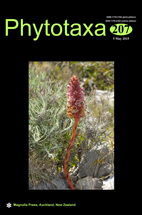Abstract
The genus Ceratolejeunea was established by Jack and Stephani in 1892 based on C. grandiloba Jack & Stephani (1892: 16) from the Colombian Andes, as the similar name given by Schiffner (1893) based on Spruce’s Lejeunea subg. Cerato-Lejeunea (Spruce 1884–85: 198) proved to be illegitimate (Dauphin 2003). The genus is mainly distributed in tropical and subtropical regions and the highest species diversity of the genus is in the tropical America with 24 species (Dauphin 2003; Frey & Stech 2009; Reiner-Drehwald 2011; Silva Brito & Ilkiu-Borges 2012). Most of species are common on bark and living leaves (Pócs 2011). The genus has been classified in a separate subtribe Ceratolejeuneinae Gradstein (2013: 14), together with Luteolejeunea Piippo (1986: 56). Ceratolejeunea is characterized and easily distinguished from other related genera by the dark color plants with pale brown cell walls, transverse section of stem with seven cortical cells and over four medullary ones, usual presence of ocelli in leaf lobes, curved apical tooth of the leaf lobule with a proximal hyaline papilla, pycnolejeuneoid leaf sequence of gynoecium innovations, inflated perianths usually with horn-like projections, usual presence of utricles on branches, and usual absence of asexual reproductive organs (Zhu et al. 2005; Pócs 2011).

